* (restored)
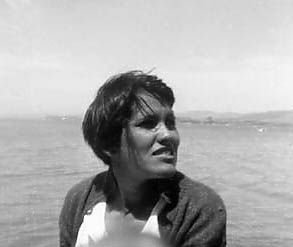
Dear Dennis, let this post introduce you to Fran Herndon, the Beat-era California painter I’ve admired and loved for the past 20 years or more. This month and next a gallery in San Francisco, Altman Siegel, is running a retrospective exhibition of her work, so I want to urge San Franciscans and visitors to come on down and take a look at it. The show has been organized by the young Canadian curator Lee Plested, assisted by myself. Maybe some of your readers will take a look at this post here, and come and see for themselves, in person, the things I like most about this strange and disquieting work.
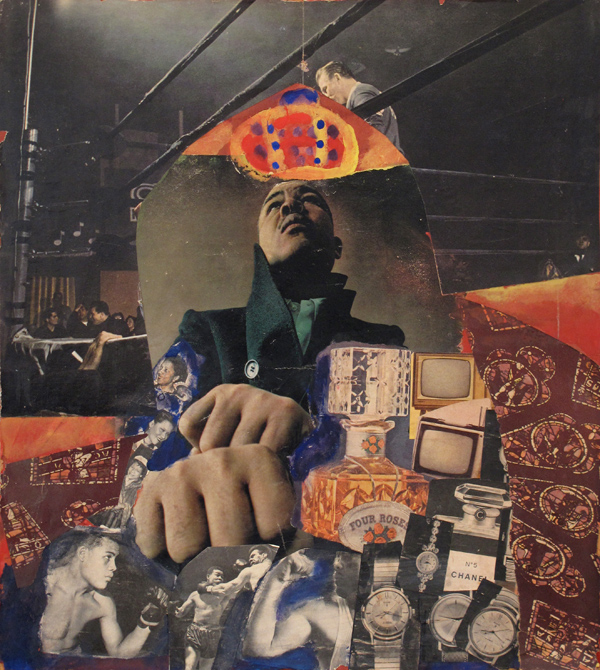
I became acquainted with Fran Herndon through my work on Jack Spicer, the poet whose biography Lew Ellingham and I worked on in the 80s and 90s. Eventually our book, Poet Be Like God: Jack Spicer and the San Francisco Renaissance, appeared in 1998 (Wesleyan University Press). When I met Lew in the early 80s, I asked him, did Spicer really know about art? (He had founded, with five of his former students at the San Francisco Art Institute, an exhibition space they called the “6 Gallery,” but you know how sometimes you do things just to go along with a pushy crowd? Maybe, I thought, maybe Spicer was weak like I am in this one regard.) Lew advised me to look at Fran Herndon’s work and then make up my mind for she, Lew said, was the visual artist with whom he was closest.
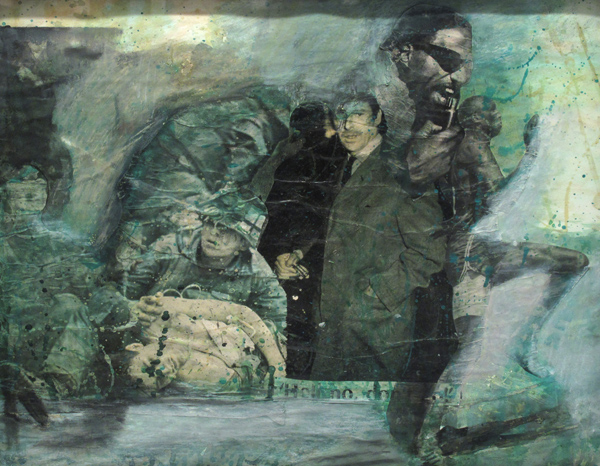
When I met her I remember feeling that strange thrill that I had when introducing myself to the redoubtable Elaine Sturtevant, or when grabbing the hand of Marianne Faithfull as she stormed into “Why D’Ya Do It” onstage at the Fillmore. Each had been there (“there” in some ultimate, Platonic sense) at the beginning, and done something unique, bizarre, beautiful and misunderstood. Fran Herndon showed me into her place in the unfashionable Richmond district of San Francisco—on an avenue totally off my route!—and it would be hard to describe what an Angela Carter-esque experience this was, but in fairy tales one is often taken offguard because one is on wholly new territory, without most of the rules one lives by, unable to cling to familiar landmarks. I wasn’t there long, but I asked her to sign my copy of Everything as Expected, and she concurred. She had been asked about Jack Spicer, I expect, many times before, but I thought if I took the high road, and approached him through her own art work, I might come up with a different angle than all those other bozos. Thus began a long engagement.

Everything As Expected is a peculiar book, written by Fran’s then-husband, the late Jim Herndon in the early 1970s. James Herndon was once quite a famous author, a schoolteacher who has written up his experiences teaching in the inner city schools of the Bay Area and made a pair of amazing books about them, works of radical pedagogy that had enormous infuence in their day. The Way It Spozed to Be came out in 1968, and its successor, How to Survive in Your Native Land, in 1971. Remember the season of The Wire that focused on public school systems and its built-in wiring for failure? Total Jim Herndon knockoff. In Everything As Expected, Herndon wrote of the summer of 1962, when Fran Herndon had embarked on a complicated series of “sports collages” under the tutelary spirit of Jack Spicer (1925-1965). Fran worked from sports magazines, tearing out illustrations that caught her eye, and making a new picture each week by arranging the found elements and then treating them with watercolor, gouache, sculptural ornamentation, mounting them on masonite, cardboard, sometimes adding homemade frames. Herndon’s book reproduces almost all of the collages finished that spring, summer and fall, adding some wry, even caustic anecdotes in the Vonnegut manner. The text becomes an extended meditation on magic—the magic of bringing something to our world, from what Spicer called the “Invisible World.” Here in San Francisco it’s easy to feel magic all around one every day, but to find its source is a sometimes terrifying avon.
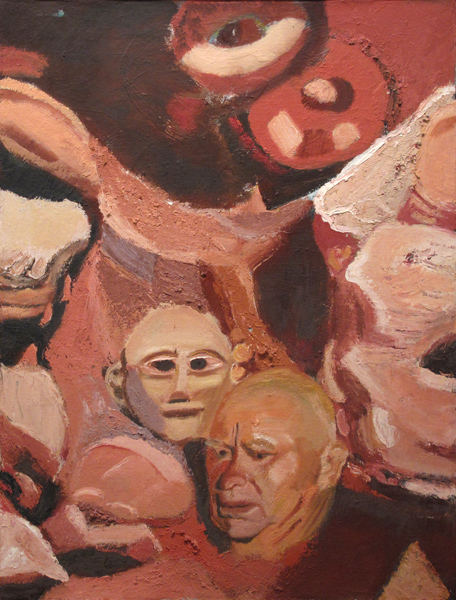
Years later, last October in fact, the curator and writer Scott Watson came to visit San Francisco from Vancouver, where he directs the Morris and Helen Belkin Art Gallery at the University of British Columbia. Scott came to attend the opening of SFMOMA’s exhibition “New Work: R.H. Quaytman,” but we organized a trip to the Richmond so Scott could pay a studio visit on Fran Herndon. We brought a second curator with us Lee Plested, who had worked with Scott at UBC and with me at CCA, the art school in San Francisco where I sometimes teach. Scott asked Fran to show us not only her most recent work, but to take us back to the beginning, to her garage, where in a stable of flat files she had miraculously kept her large paintings from the earliest days of work. I hadn’t seen but the tiniest number of these pictures before, and Lee, whose first meeting with Fran this was, was as blown away as I. He hit on the idea of somehow organizing a show to exhibit this early work, and within a week or two after our visit announced to me that he and I were going to curate it together, and that he had secured the participation of the gallerist Claudia Altman Siegel, and the thing was practically was for the fall. Well, that was around the New Year, and now months and months later the show is up.
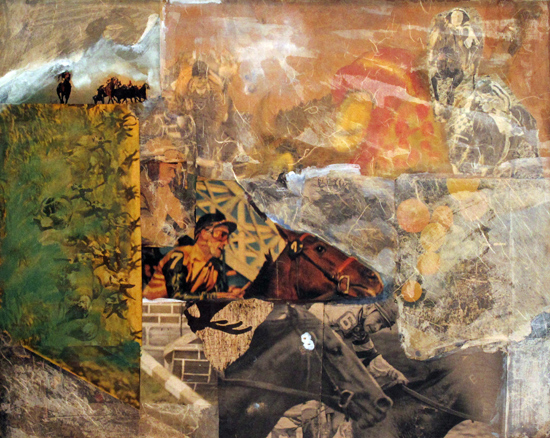
Fran has always maintained the respect of coterie of experimental poets; from Spicer, Blaser, Duncan, George Stanley and Jess in the early days, to the very young of today. In recent years the poet Avery Burns and his wife, Andrea Koehler, have organized several shows of Fran’s work at the North Beach gallery Canessa Park: beautiful shows, vivid, wildly ornate and personal. Altman Siegel is a very different sort of art space, clean, uncluttered, with a clientele of international artists, curators and collectors, what my dad would have admiringly called a “blue chip” gallery. At 82 or 83 this was a different sort of opening for Fran Herndon, but she was there, still somehow as young as she was the day I met her, very radiant and composed under this new, somewhat bewildering barrage of attention. (Dennis, even Christian Marclay poked his head in.) Here’s the essay I wrote for the catalogue of the present show, which closes at the end of October, please go in and take a look if you’re in town.
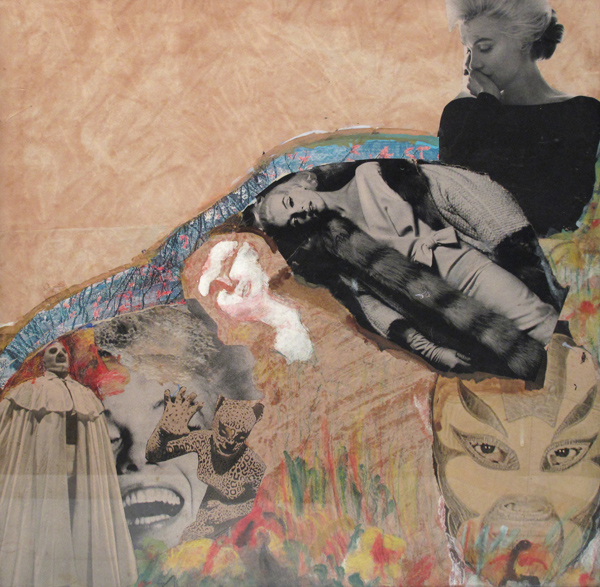
Fran Herndon
prepared for exhibition, “Fran Herndon,” at Altman Siegel Gallery, September 8, 2011

Born in Oklahoma in 1929, of Native American origin, Fran Herndon escaped to Europe just as Senator Joseph McCarthy turned this country upside down. The US, she told us recently, was then “no place for a brown face.” In France she met and married the teacher and writer James Herndon, and the couple moved to San Francisco in 1957. (The first of their two sons, Jay, was born the same year.) Shortly after arriving in the Bay Area she met four old friends of her husband’s: Jack Spicer, Robin Blaser, Robert Duncan and Jess—the brilliant crew that had invented the Berkeley Renaissance ten years earlier, artists now all working at the height of their poetic powers in a highly charged urban bohemia.
Fran Herndon became most deeply involved with to the most irascible of them all. From the very first evening that they had spent time together, Jack Spicer (1925-1965) seemed to see something unusual, something vivid in Fran that she had not seen herself. It was as if he were establishing a person, the way he created a poem, out of the raw materials she presented, and for a long time she did not know what it was he wanted her to be. Fran was mystified but elated by a power that Jack saw hidden inside her demure, polite social persona. He knew before she did that she would never be completely satisfied with the roles of mother and housewife.

—-When Spicer scrutinized her, as if envisioning in his mind’s eye a new and somehow different person, she began thinking: there must be some off-moments from being a mother—and during those moments what would she do? “I remember clearly discussing school with him. And out of the alternatives I mentioned, he zeroed in on the Art Institute.”
She began to drop off two-year-old Jay at a nursery school in North Beach, and walk up the hill to the Art Institute on Chestnut. She was quietly astonished at this turn of events, but already Jack was “a very powerful figure in my life. His opinions were crucial.

“He saw in me,” she recalls, “something greater than I saw in myself.” In 1959 she and Spicer inaugurated a series of joint projects, beginning with their editorial work on the mimeo magazine “J.” Simultaneously they collaborated on Spicer’s poem “Homage to Creeley,” each working independently and meeting weekly to share results. “J” was devised as a reply to the Beat magazine “Beatitude,” recently launched in San Francisco by Spicer’s rival, poet Bob Kaufman. Spicer and Herndon launched an open letter, saying what they wanted and more importantly, what they didn’t want. Submissions were to be left in a box behind the bar at The Place, a promiment poetry/ jazz/ performance space in North Beach. Fran took charge of the artwork, requiring her artists to work in stencil or typewriter font or a combination of both. Under the constraints of DIY was born what has been called “in many ways the most beautiful of all the mimeo magazines” (Steven Clay and Rodney Phillips, in A Secret Location on the Lower East Side: Adventures in Writing, 1960-1980, their 1998 survey of mimeographed poetry journals and ephemera.)
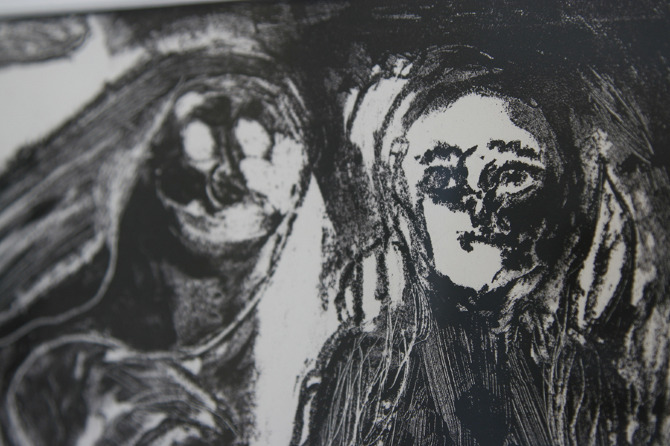
—-Simultaneously, Spicer’s “Creeley” poems and Herndon’s lithographs startled and enchanted them both.
In the evenings Spicer came by the Herndons’—sometimes three or four times a week, sometimes every night. Fran felt herself waiting for his visit, convinced of the link between the lithographs she was creating and the poems that were pouring out of him. He was never present while she worked on her graphics, and she never saw him writing, but somehow the results of their private endeavor meshed in a way that seemed perfect to them both. Jim Herndon later wrote about the experience. “Jack would show up at his certain night with his new poem and Fran would have a new litho. Jack would point out a correspondence between the two. He would show how Fran couldn’t have known about the content of the poem. He would show that he couldn’t have known about the image in the litho.” Fran said, “Sometimes it was reaching, but he knew that there was some connection in [my] work and what he was writing. It was as if at times it was prophetic (I mean, he would never have expected that to happen)—and he was just ecstatic when he could see that connection. At times it surprised me, because I had no inkling of the poems that were preceding or coming after those lithos. He saw it as not in any way illustrating the poems, but just an interaction of some kind.”
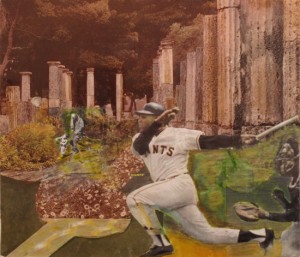
She was skeptical, but wavering. She wasn’t sure what to believe. Herndon wrote, “She wanted to forget it. She wanted to have it. She didn’t want ghosts drawing her lithos. She hoped they were. She wanted the visible. She loved the litho-stone, apparently firmly connected to the invisible. One night Jack produced a poem about a white rabbit absolutely outlined in whiteness/ upon a black background and Fran produced her litho of a white rabbit absolutely outlined in whiteness upon a black background, and the correspondence between the two was thus exact, as if the ghosts had gotten tired of just hinting about it.” This experience lasted no longer than four or five months. “It was a magic process.” She loved the litho stone she used, its perfect smoothness and porousness, its absorption of acid. Never again, she recollected, did she achieve the singularity she achieved with the lithos for “Homage to Creeley.” “Somehow when the poems were finished, that’s when it was over, really.”

In the meantime Fran turned to painting, and never really looked back. (Her second son, Jack, was born in 1960). The work in the present exhibition is largely drawn from a furiously concentrated period of time, where she painted as though her life depended on it. In these pictures all of American painting seems drawn into the vortex: the social realism of such predecessors as Grant Wood, Thomas Benton; the furious blend of abstraction and figuration that flowed into De Kooning’s brand of “action painting”; the canny, mystic attention to details of nature and landscape of Marsden Hartley and Georgia O’Keeffe. Pop art, too, figuress into the mix, and the mixed media suspensions of Rauschenberg, Bruce Conner and Jess. Not here, buit in the library at Special Collections of SUNY Buffalo, hangs Fran’s portrait of Robert Duncan, festooned with spakrly cloth to represent his shirt of many colors. In the present exhibition note the thickness and the sculptural mass of the paint, writhing and byzantine, as though trying to p[ry itself loose of the canvas. In “Opening Day,” the exuberant, rabbit-filled picture of Willie Mays, number 24, Mays’ famous words float in medieval gold. “I don’t compare ‘em,” he told a sportswriter in 1959, on being awarded his third Golden Glove award. “I just catch ‘em.” Similarly Spicer never took credit for his own poems; they didn’t really belong to him, he said, he hadn’t written them, he had just received them from an outside force he called the “Invisible World.”
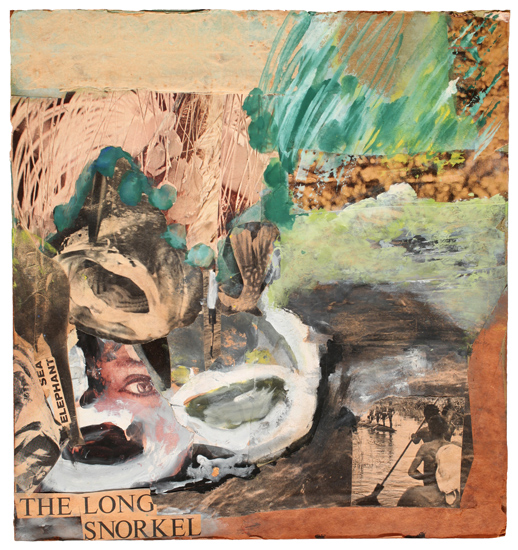
Spicer couldn’t type, and entrusted the manuscripts of his new book-length projects to Fran’s secretarial skill. She typed The Holy Grail for him, as it appeared to him little by little, in 1962, and created a series of lithographs centering on the figures in the Arthurian legend. (“Percival” 2 and 3 appear in the present exhibition.) At the same time, Fran completed the “sports” collages that make up her most intriguing achievement in art. The lithographs for Spicer’s “Homage to Creeley” were, of course, black and white; in the collages she burst into color as though entering a paradise of revealed myth and truth. Across town Jess was creating a similar series of “paste-ups,” like Herndon ripping and slicing up visual images and rearranging them onto canvas. Spicer assigned Herndon the humble pages of Life and Sports Illustrated for her materials, and she painted over and under these images and achieving a rich, often misty glaze. The subjects of this series were sports-world versions of betrayal, tragedy, and loss, such as the trade of Y. A. Tittle for Lou Cordelione by the San Francisco 49ers—“King Football”— the first Liston-Patterson heavyweight fight; the scandalous death of the boxer Benny “the Kid” Paret. “The Devil and Archie Moore.” “Collage for Jim Brown.” Take the haunting “Catch Me if You Can”: Herndon;’s brushtrokes transformed the photographed horses straining for the finish line into wraithlike creatures, like Kandinsky’s horses, not “real” beasts but expressionistic, ephemeral, alert animals, closer to unicorns. Perspective is flattened: foreground and background keep switching, giving the collages a watery, dreamlike quality removed from Jess’ ornate, precise surrealism. The “sports collages” also are very direct about race subjects; in the throes of the civil rights struggle, America was ripe for the sort of rich, dazzling imagery Herndon brought to her athletic subjects; there’s tragedy and anger here—as in the later anti-draft, anti-war collages—but there’s also a glorification of black and Latino athletes that anticipates the work, forty-years later, of a later SFAI graduate, Kehinde Wiley. Even Marilyn Monroe pointedly becomes The White Angel, in Herndon’s memorial collage of the same name; we see first Bert Stern’s memorable Vogue image of a fretful Monroe, then her whiteness collapses into a mad sprawl of faces, body parts, skull, wraith and animal imagery as she sinks underground into the dark.
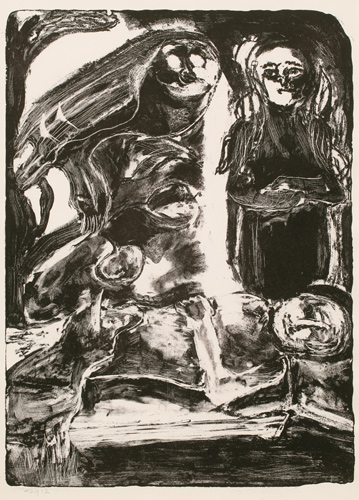
—-These pictures were made by a kind of given chance structure, whatever was featured on the cover of Sports Illustrated from week to week dictated the image stucture of the work. That was the magic part; the rest was up to Fran Herndon, and into art history through a very long circuitous route.
All the artists in the Spicer circle vacillated between trying to get their work shown, and another, queasy feeling that art was over. In addition, Spicer was intently contemptuous of those who tried to make money from art or writing. His own books were issued without copyright. Anyone who published a poem in a magazine outside of San Francisco was labelled a “sell out” to the larger, eat-em-up consumer culture. Or they were part of what he called the “Fix.” It would have been enormously difficult to move out from beneath that psychic plane, that heavy disapproval. In Secret Exhibition, her 1990 survey of Bay Area art, that focusses on “six California artists in the Cold War era,” critic Rebecca Solnit employs a cultural studies approach to analyze the propensity of many San Francisco artists to make art in secret. On the one hand, such propensity stems from occulted traditions, including that of the hermeticism of the artist; in another light, as Solnit shows, San Francisco was so far off the art map that the artists she describes felt curiously free to invent their own, tiny, freakishly distorted art world, and a new kind of art to show in it: the funk-junk assemblage rag bag thing we all know well now. Few artists took any precautions to preserve their work, taking a Darwinist view, “sink or swim,” or perhaps yielding to an Existentialist urge to cast one’s fates to the wind. Documentation was unheard of. The scene was thus rather nihilistic. And gave birth to a lot of artists-run spaces, from the King Ubu Gallery of 1952 to the Batman Gallery later in the 60s. Spicer and five of his students from the California School of Fina Arts established the “6” Gallery in 1953. But Solnit’s book omits discussion of the galleries run by this group of artists, Borregaard’s Museum of 1960; the Peacock Gallery of 1963; and Buzz, the gallery organized by Paul Alexander, Bill Brodecky and Larry Fagin in 1964. The outsiders and rebels of Solnit’s world, whose work was shown in the big Whitney show of 1995, “Beat Culture and the New America,” had only a very distant interest in this group, who were beyond the pale in many ways, even to the outsiders of Secret Exhibition.
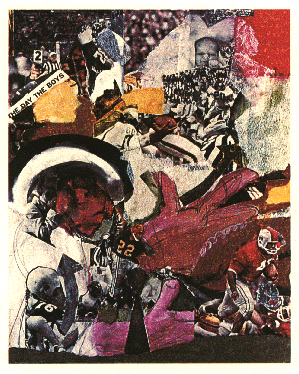
—-The problem with artists-run spaces is, of course, that though they deliver the means of distribution back to the producer—which has a beauty of its own, an exhilarating freedom—they depend on continued enthusiasm, and enthusiasm comes easy at first but quickly slows to a trickle. Thus Borregaard’s Museum, the Peacock Gallery, Buzz lasted only a few seasons at most. The present exhibition gathers together a representative sampling of Herndon’s portion of the grand November 1963 Peacock Gallery show organized by the poet Robin Blaser (1926-2009). If you squint and look at the splendors of “Ophelia,” “Tile Rats,” “Will the Circle Be Unbroken?” or the sublime “Doodlebug,” it might almost be 1963 over again.
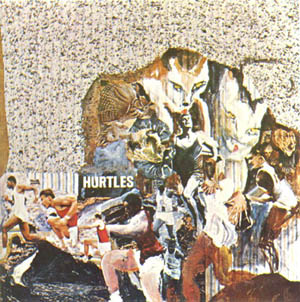
In the 1970s, as contemporaries like Jess, Bruce Conner, Jay DeFeo began finding fame, Herndon put aside art for personal reasons, and when she returned to painting she did so in a deliberately lowkey, unheralded way. But in that period a coterie of admirers from many disciplines has grown vocal, and through a sprinkling of small but important exhibitions, interest in her work has reached a new height. Fran Herndon continues to make paintings and collage in her home studio in the Sunset district of San Francisco.

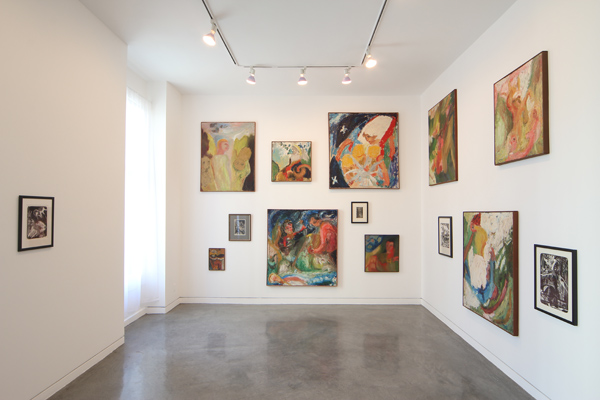
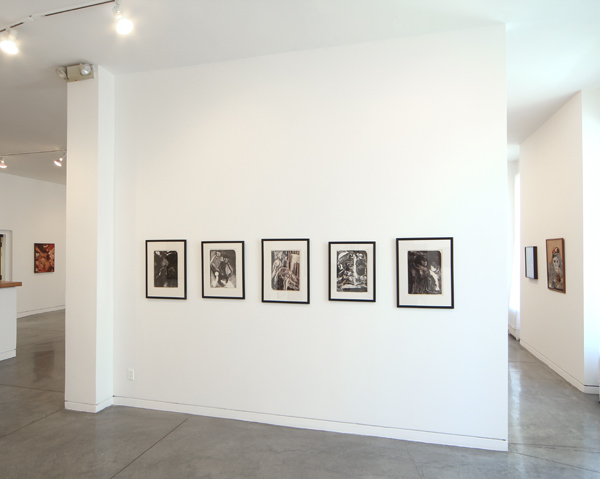

 —-
—-
*
p.s. Hey. My dear friend and literary comrade/hero, the late and very great writer Kevin Killian, guest-hosted several posts for my blog over the course of the years. I will be restoring them for the obvious reason that the excellent and generous work he did for this place should be available to all. This, the first restoration, is his introduction and homage to the little known Beat era, San Francisco-based painter Fran Herndon. I hope you enjoy it. ** Shane Christmass, Hi. No, I haven’t seen that film. That conclusion you speak of is enough to get me hunting for it, of course, and the clip looks fun enough. Thank you. Nope, haven’t heard the Freddie Gibbs / Madlib album. I’m guessing you think I should? Assuming I’ve guessed right, I’ll check it out. And I have been following that news story, but only since finding that article you linked to. That gave it the extra spin my interests needed. Thanks again and overall, man. ** David Ehrenstein, Indeed they are. Your sale is still on? Did you ever see Steve Erickson’s question as to whether people in other locations can purchase things through the post? Everyone, Mr. Ehrenstein’s big house sale is still ongoing. And today he asks if anyone is interested in back issues of “Cahiers du Cinema”. Hit him up, if so. ** _Black_Acrylic, Hi. Yes, based on those photos, the failure of that particular park is vastly understandable. Yesterday was unspeakably brutal here. Jesus. Today the temperature is lower but the humidity is sky high, so it’s much better but no picnic. Enjoy your surrounding pleasantness. ** Bill, Hi. Well, the building that housed Planete Magique is now Gaite Lyrique, a prominent Paris venue for experimental music and multi-media art shows. Recently Tim Hecker, Keiji Haino, Oren Ambarchi, and Sunn0))) have played there, for example. There isn’t the slightest trace of the amusement park. It was gutted and reformed. But Gisele tells me that, during the transition when the place was a ruin and looked exactly like the photos, it was a hot spot for illegal raves. I haven’t been able to find any video evidence of them, sadly. The other park is just a giant empty swamp now. Yes, Spreepark. I was going to go visit its remains the last time I was in Berlin, but it was too much a trek given the time limits. Dude, it was 108 degrees yesterday! The hell it was is unimaginable even to me who barely lived through it. ** Steve Erickson, You’re going to be a beats maestro! Now that’s interesting. Link us up. Oh, man, it was really fucking brutal yesterday. The air was so hot and thick it was hard to breathe. It was still 106 degrees when I went to bed last night. I live across the street from an IKEA, and, when I briefly ventured out yesterday to buy cigarettes, I saw that, due to its air-conditioning, the police had commandeered the store, and they were directing old people and homeless people inside where there nurses and stretchers and things to treat people. Never seen anything like that before. Just crazy. I have followed Ka5sh a bit, and, like you, I haven’t found any of his recent stuff to be very interesting at all. Seems like he might have shot the exciting part of this wad in the initial burst. ** Right. Be with the wit and wisdom and knowledge-sharing of the much missed Kevin Killian today. See you tomorrow.




 Now available in North America
Now available in North America 
these are wonderful, dennis. i’m sure you understand i heard KK’s voice as i read this.
just thanks for this. You and Kevin both seem to have several lives. There’s so much.
Nice memento of Kevin. As Always Not A Day Goes By
I’m not sure what you mea by “purchasing through the post” If you’re looking for something specific write me at cllrdr@ehrensteinland.com I’ll supply info on how to mail things te and you can supply info of how to mail things to yu. But this all depends o knowing wht you want. It’s easiet if you’re in L.A. and can drop by. As for “Cahiers” I have issues from the 60’s through the 90s and I’m quite willing to sell them in bulk
Wonderful blog today. It’s always a remarkable discovery when one sees an artist that somehow fell through the cracks of time. Kevin was good at that. And the heat. I don’t think Paris was built for such weather. Stay calm, collected, and cool. Do homes there even have air conditioning?
Fran Herndon is a new name to me and her work here is extraordinary indeed. I’m thankful to KK for this introduction.
Here’s hoping Paris continues its bearability upswing. Dundee tomorrow is forecast a monsoon-like downpour, and I hope to peruse the Generator Projects Jumble Sale without all the wares being washed away.
Kevin’s work lives on through this blog!
With climate change making extremely hot summers a permanent fixture of our weather, do you think AC will become an increasing part of Paris life? I don’t know if you and Yury can afford this or the utility bills that will follow, but can you just go buy an air conditioner and put it in your apartment window?
Have you heard about the Mexican avant-garde Colectivo Los Ingravidos, who have posted 362 short films on Vimeo? They’re getting an increasing amount of attention, with 2 films screening at the Whitney Biennial in September. A review of three of their shorts on Michael Sicinski’s Patreon page alerted me to them – POSTAL is excellent. Their work seems to synthesize sensory overload and near-subliminal aggressive editing, political references and a spiritual element.
Here’s the link to the collective’s Vimeo page, where you can stream all their films for free: https://vimeo.com/user15819885
Dennis, No better a tribute to Kevin than one of his great posts for your blog, imo.
No news from the doc, which is good news. She’s proactive on that stuff and would’ve called me right away like she did my mom when my mom’s gall bladder rebelled against her.
Yes, ol’ LPS. And now his sister. Totally wrecked her car real late Thursday night. Drunk driving. Hit a fire hydrant. No police got involved. No one else was involved, and she and her passenger were okay. We got it towed that night. Well, a po po did show up but he was about to get off work and didn’t even get out of his car. He didn’t know about the hydrant, though. Anyway, he just told us to get it towed or he’d have to. She’s in a rental car now that the insurance company is paying for. I’m thinking the car will be totaled, but who knows?
I’ve slept maybe 3 hours in the past 24 thanks to these rotten kids.
Lovely to see this revived post, Dennis. I should try to see if any local venues have Herndon’s work.
No Baiza tonight, I’m afraid. But I’m pretty committed to see the Golia gig tomorrow. Hope your temperatures are plmmeting as I type.
Bill
Folks will want to know that Fran Herndon died on May 24th. Her son Jack says “she died peacefully in her sleep and was cared for, in good spirits, and not alone.” Fran was truly a special person, and she and Kevin were devoted friends. Thanks so much for putting his blog up.
There may be a Zoom memorial for Fran in the not-too-distant future (and perhaps even a public one, depending on the pandemic) but nothing definite just yet.